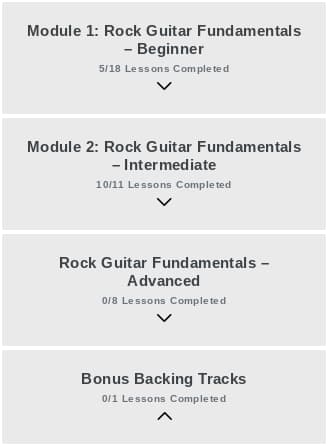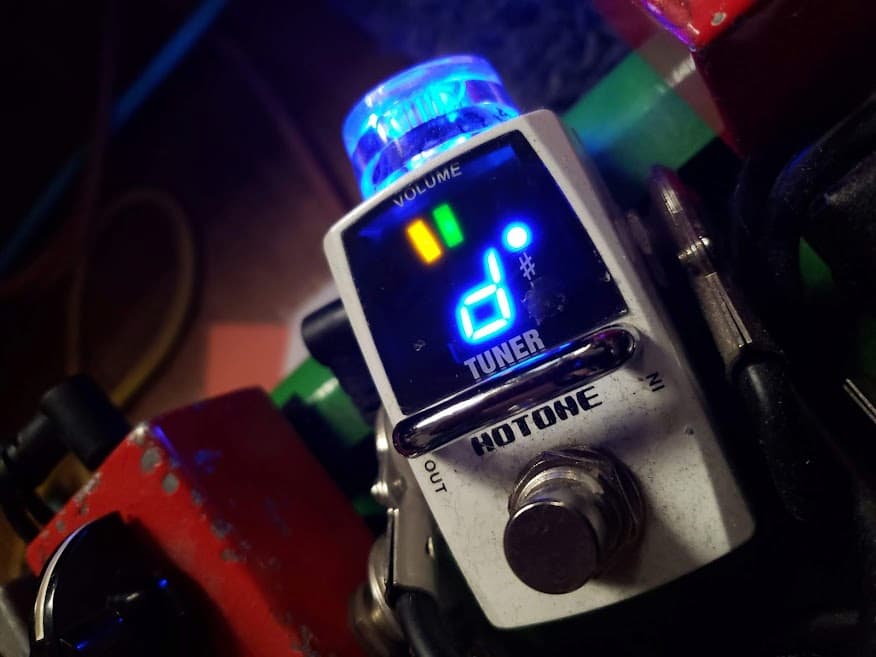If you’ve listened to anything I’ve ever recorded, you’ll know I’m not much of a technical guitarist. I had been thinking about getting lessons of some description to improve this. So, when Alice Cooper guitarist, Nita Strauss, launched an online course, I was intrigued. Intrigued enough to pay for it and use it enough to confidently review it.
Background
Although I’ve played guitar for 25 years or so, I’ve never been very technical. I had a few lessons when I started to get me playing Oasis chords, and that was kind of it. I never learned about theory or scales or harmonies. The extent of my knowledge of solos was a bit about pentatonic minor scales in a copy of Total Guitar, related to a feature teaching Champagne Supernova.
I’m aware of the big shredders – Vai, Satriani, Malmsteen etc. While impressed by their playing, it never captured my imagination in terms of aural aesthetics.
Frankly, for the most part, they all sound the same to me.
However, I have full respect for the technical knowledge, and technical ability they obviously have to be able to do that stuff.
Finding Nita
I can’t remember how Nita Strauss got on my radar as a guitarist, but I had followed her on Facebook for a couple of years, and that’s where I saw the launch of her own Rock Guitar Fundamentals online course.
Similarly, I can’t pinpoint when I started thinking about getting lessons to improve my lead playing, but it had been on my mind for a while. Then Nita’s course appeared on my Facebook news feed.
Like, yeah, there are a bajillion online courses. And yes, a lot of cheap or free ones, especially on YouTube. But, as I’ve stated before: you get what you pay for. I’m not going to rehash her Wikipedia page explaining her credibility to justify paying for her knowledge.
The bottom line is that she plays for an artist I like, she’s well-regarded as a teacher, and she does a lot for female guitarists.
If I recall correctly, she had a promotional video for it where she looked like she was having a blast sitting on a couch demonstrating something. And as playing guitar is her bread and butter, I figured quality presentation would be more important to her than a YouTube rando.
Finally, her course had a $50 launch price. That was pretty affordable to me, so everything seemed fine.
I will say, when I first signed up in May 2020, I just dipped into a couple of lessons. I didn’t really, REALLY get stuck in until I was quarantining when I visited my family in Ireland for Christmas.
Nita Strauss: Rock Guitar Fundamentals: tech specs
Ordinarily, I review gear and have a nice table of tech specs.
But, in this case, the only tech spec really is that this is an online course. This means that to use it, the tech spec on your end is more important, and that’s an internet connection. And, because it’s a video-based course, it should be the best you can find.
Apart from that, you can watch it on any device with an internet browser – desktop, laptop, smartphone, tablet… whatever. However, personally, the idea of squinting at my phone screen to see finger placements and tabs does not appeal.
Getting started
Enrolling in the course is as simple as having a credit card, and completing the information – just like every other thing you’ve ever paid for online.
Once completed, you set up your login details – just like every other thing you’ve ever set up login details for online. Then you have access to the entire course forever. Hurrah!
Course structure
With my account set up, the first thing I did was nose through the course to see what was up.
There are 38 lessons, split into three modules: beginner, intermediate, and advanced.
All the lessons are relatively short. I think they range from about two minutes up to seven minutes, or something like that. These are perfect length modules for people pressed for time, like me.

Beginner
The first module really is for people who have never picked up a guitar before, covering things like naming the guitar parts and strings, terminology, and basic chord formation.
As I’ve been playing for 25 years, I did skip most of that first module. But I was delighted to see a dedicated lesson on using a tuner pedal! If that lesson inspires just one unsigned musician to invest in one, the world will be a better place.

Seriously, I’m having flashbacks to bands passing one cheap tuner between two guitarists and a bassist. Setting up is quicker if you have your own right there on your board. It’ll make you sound better than your three overdrive pedals.
Sorry, I digress. But still, it’s really fucking important!
One lesson I did look at was Single Note Fretting Technique & Chromatic Run In 1st Position. I guess I was drawn to it because it was the only lesson in the beginner module that had a term I wasn’t familiar with: “chromatic run”.
Dear reader, I won’t detail the lesson, because you should pay for it. I will, however, detail its impact on me. Now, I’ve been a lazy pinky player all my guitar-playing life. But, let me tell you, that little lesson woke my pinky up! It was like I’d grown a new finger!
Straight off that lesson, I came out with a riff with more pinky action than I ever could have imagined playing!
Best of all, the teacher liked it!

It’s really lovely to see her engaging like that.
Intermediate
This module was about right for me, and my playing knowledge and experience. And I got through them as part of my routine in quarantine to keep my brain occupied so I didn’t go crazy.
This module focuses more on scales and single-note picking, which is what I desperately needed. The lesson on Fretboard Finger Independence was really useful, as were the lessons on the major and minor scales. I’ve been sure to keep practicing those.
I was also super-interested in the lesson about modes. But I still don’t think I get them. I should revise that lesson. It’s easy to do that because I have access to them forever!
Advanced
I haven’t actually started on the advanced lessons yet.
Firstly, I feel like I need to master the lessons from the intermediate module, in terms of dexterity and speed.
Secondly, the lesson list has scary names that I associate with shredding like, Tapping-Two-Handed Tapping and Sweep Arpeggios.
Urgh. I should JFDI though, shouldn’t I?
Nita Strauss: Rock Guitar Fundamentals: conclusion
If it’s not clear by now, overall, I’m a big fan of the Nita Strauss: Rock Guitar Fundamentals course.
Personally, I feel like my playing had become stodgy with the limited tuition I had. Now, it’s like it’s had a whole new lease of life. I’m getting exactly what I wanted and needed out of the course.
While I know that it won’t work for everybody, because everybody learns in different ways, here’s what I liked.
- Short lessons: finding 10 minutes to practice guitar is a big deal for me
- Muliple camera angles: usually, online guitar lessons are fixed shots of the teacher’s upper body, with an in-screen shot of their fretting hand; I don’t find it engaging – this is better:

- Nita explains techniques concisely, speaking slowly and clearly: I feel like a lot of online teachers rush explanations so they can get to playing; that just doesn’t work for me – I need a second to think about how I’m going to do it
- Affordability: I think the regular price is $99, she has sales on it pretty regularly; it’s worth noting that that’s a one-time payment – not a monthly or annual subscription
- PDFs: you can download PDFs with notation and tabs of the lessons right there on the page; I feel like with YouTube lessons it’s usually a case of, “Here’s the video lesson; if you want the tabs, you need to dance with a chihuaha in the pale moonlight, while knitting a hat for their friend, the pizza”
In fact, the only thing I find annoying is that the course is called Rock Guitar Fundamentals, but the URL for the course is IWantToPlayGuitar.com. But that’s the marketer in me who likes consistent branding.
Who should spend money on Nita Strauss: Rock Guitar Fundamentals?
Nita Strauss: Rock Guitar Fundamentals really is about the fundamentals – it’s not just a name. If you’re able to do all the things in the course confidently and competently, then it’s not for you. Obviously, there are always things to learn and boundaries to be pushed, but it’s unlikely you’ll do that here with Nita.
I’d recommend it for noob guitarists, and intermediate guitarists who need a fresh perspective.
I don’t think you need aspirations of shredding, but I don’t think anybody can disagree that a well-respected guitarist and teacher is great to learn from, whatever your music taste.
Learn more on the Nita Strauss: Rock Guitar Fundamentals website.
Total sidebar: in writing this, I read more about Nita’s background. Her dad played bass in a band called Jiva in the 70s – hence the name of her signature model. They were signed to George Harrison’s label. Their back catalog is on Bandcamp, I’m listening to their first album as I type this, and I dig it. It’s just good solid rock music with laid-back Cali vibes.
Thanks for reading!
If you found this helpful, subscribe on the right-hand side of this page. You’ll be notified of new posts on Thursdays, inspiring you going into the weekend.
And share why you found it helpful. Because it helps us, and others!
Share your own light audio recording thoughts and experiences! There’s a Facebook group, a Subreddit, Twitter, and Instagram.
Also, on LinkedIn, you can see the business brain of Light Audio Recording at work.
Finally, this is a music project, so we’re on Spotify – the playlist below starts with the most recent release and works backward. So, feel free to follow us!
However, do remember that it takes 2,000 plays on Spotify to generate a single dollar, so it would take 6,000 plays to get a coffee…
